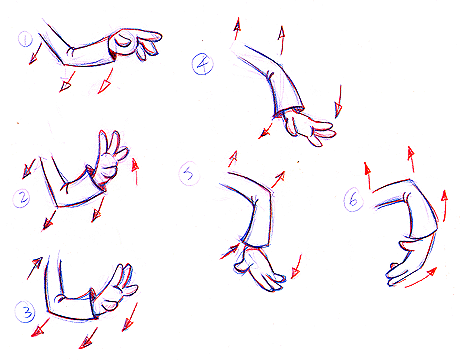Overlapping Action is another of the cornerstones of animation. By overlapping the actions of a characters' body, hair, tail, clothing, etc. your animation will feel more fluid and life-like.
In life, everything moves at different speeds and at different times. OVERLAPPING ACTION is a tool used by animators to emphasize the action and mood of the character. When a character moves across the screen some parts of the body move before or at different rates than others. Some parts of the body will LEAD the action and some parts will FOLLOW the main action.
Here is a “jump” action. The main action begins with the legs. They are the motivational force of the action. In other words, the legs make the action of the character stop and start. The legs motivate the action.
HINT: The spine and the head and the arm movements are secondary - and they are overlapping actions (they continue moving even after the legs stop).

If we take the same “jump” action and add a dress or tunic on the character along with some hair - look what happens.
HINT: When animating a scene begin with the main action and then add the overlapping and secondary actions.
From a practical stand point, one of basic elements of OVERLAPPING ACTION is the use of “S” curves when something changes direction.
Here is a head moving up and down. Notice how the hair trails (or drags ) after the main movement oh the head.

Because the hairs' weight is light- is seems quite floppy. When the head tilts up the hair drags after it. When the head begins its downward movement the hair is still on its way up. At some point, the hairs' action will change direction when pulled by the head. This “pulling” creates an “S” curve as the hair is pulled (and transitions) into the same direction as the head.
The “S” curves are a key element in creating fluid OVERLAPPING ACTIONS.
Next we have a “head turn” movement - again with the same floppy hair. Notice the “S” curves in drawings 3,6 and 8.

The leading and following action principles apply to simple body movements.

Even a simple arm raise movement employs leading and following actions. In this action the shoulder leads the elbow which leads the wrist which leads the finger tips. This is called successive breaking of joints.
HINT: each part of the body involved in the action has its own arc (in this example we mean the shoulder, the elbow. the wrist and the fingertips all have arcs).
Have a ball bounce up and own in a cycle - then add a light skirt to the ball. Look for the “S” curves during the transitions of the skirt’s direction. ALSO: Try to DESIGN each shape of the skirt. Check your positive and negative areas, etc.

No comments:
Post a Comment